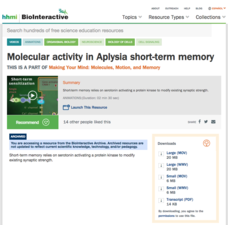Curated Video
The Lifecycle of a Virus
This video is a lecture on the life cycle of viruses. The speaker starts by explaining that viruses are not true organisms because they are made up of different components and cannot replicate on their own. The video breaks down the...
All In One Social Media
10 FREE Social Media Tools To Streamline Your Social Media Marketing
What social media marketing tools should you be using for your business? I have put together my 10 favorite social media marketing tools and the best part is, they are free // T I M E C O D E S 0:00 - Intro (10 free social media tools)...
Curated Video
Lytic cycle: the reason why bacteria hate viruses
Bacteria hate viruses called bacteriophages, and rightfully so. These viruses are vicious! They make bacteria their hosts and create multiple copies in a process called lytic cycle. In this video, we will do a quick review of the main...
Curated Video
Cellular Respiration: How Do Cells Get Energy?
Cellular respiration is the process through which the cell generates energy, in the form of ATP, using food and oxygen. The is a multistep biochemical process where food, primarily the carbohydrate glucose, is broken down to produce...
SciShow
A New Mathematical Model of the Origin of Life
Scientists have once again used big, complex math equations to help us understand more about the universe we inhabit, this time about the origins of life on earth.
Catalyst University
Lactate Threshold & Onset of Blood Lactate Accumulation (OBLA)
In this video, we dissect the physiological meanings of Lactate Threshold & Onset of Blood Lactate Accumulation (OBLA) with increasing exercise intensity.
Catalyst University
The Pacemaker Potential EXPLAINED
In this video, we discuss how the electrical conduction system generates a pacemaker potential by viewing the action potential diagram.
Visual Learning Systems
Exploring Plant Reproduction: Sexual Reproduction in Plants
This engaging series of videos uses colorful animations and on-location footage to illustrate some of the amazing ways plants reproduce. The reproduction processes in bryophytes, ferns, gymnosperms, and angiosperms are highlighted....
msvgo
Water Cycle
It explains the three states of water and talks about the steps involved in a water cycle.
SciShow
The Quest for Glueballs
The quantum world is weird. Today we're looking at a strange particle called a glueball that contains no matter...they're made of pure force!
Catalyst University
Basics Parts to an Electrokardiogram [EKG]
In this video, we discuss the following: [1] the main three parts to an EKG. [2] the electrical & mechanical events they each represent.
FuseSchool
Another Way To Divide Positive & Negative Numbers
Another Way To Divide Positive & Negative Numbers | Numbers | Maths | FuseSchool Learn more advanced rules of how to multiply directed numbers!
Curated OER
Cell Cycle, Mitosis and Meiosis
Aren't mitosis and meiosis the same thing? A helpful flow chart demonstrates the difference between mitosis and meiosis on Paul Andersen's Smart Board. Time lapse videos include show mitosis and cytokinesis.
Teacher's Pet
Mitosis and Cytokinesis
Be careful when discussing mitosis, it's a divisive issue. The video explains the mitosis and cytokinesis portions of the cell cycle. It discusses the prophase, metaphase, anaphase, and telophase in detail.
Khan Academy
Mitosis, Cells, MCAT
The lecturer starts by emphasizing that the mitotic process is a separate mechanism from cytokinesis—the cytoplasm splitting to become two cells. The video continues by explaining the stages of mitosis in great detail. Each stage is...
Teacher's Pet
Photosynthesis Steps and Pathways
When studying photosynthesis, most pupils think of trees and flowers but forget about cacti. The video explains the process of photosynthesis both within a cell and the variations due to the type of plant and climate. It includes a short...
Bozeman Science
Reproductive System
The human reproductive system contains the largest (egg) and smallest (sperm) cells in the human body. It's time for scholars to review the differences between asexual and sexual reproduction. The instructor reminds them how meiosis...
American Chemical Society
How Seashells Are Made
What do chalk and seashells have in common? They are both primarily calcium carbonate! Learn how sea creatures use crystalline structure to their advantage as they build their shell homes. An installment of a larger series on reactions...
Howard Hughes Medical Institute
Molecular Basis of Early Ltp (Short-Term Memory)
Digital amnesia: forgetting information one easily finds online. Learn how our brains move information into short-term memory at the molecular level with a short animation sure to make a memorable impression. Viewers observe a...
Howard Hughes Medical Institute
Molecular Activity in Aplysia Short-Term Memory
Scientists have yet to find the limit on the human brain's capacity for memory storage, so the potential is limitless! An animated video demonstrates how the brain places information in short-term memory. Viewers observe the...
Howard Hughes Medical Institute
Molecular Basis of Late Ltp (Long-Term Memory)
Scholars compare and contrast the molecular changes for short-term and long term-memory with the help of animated videos. Viewers see the chemical process that changes the brain and stores memories thanks to dopamine.









